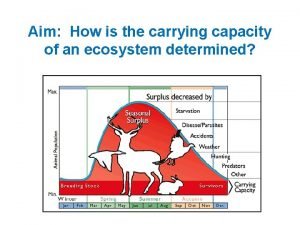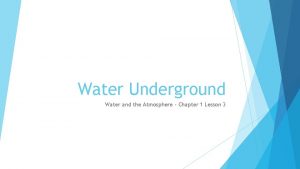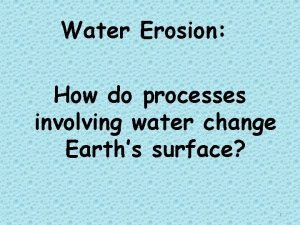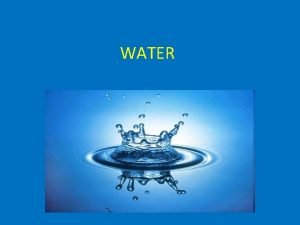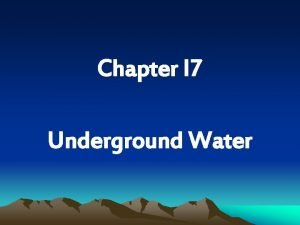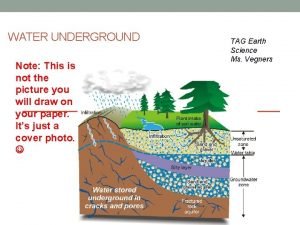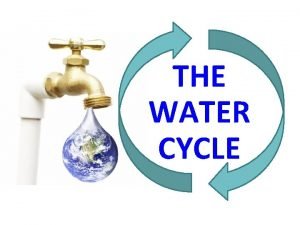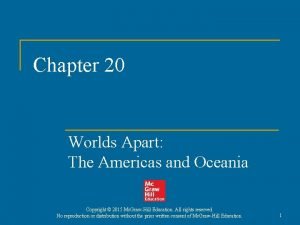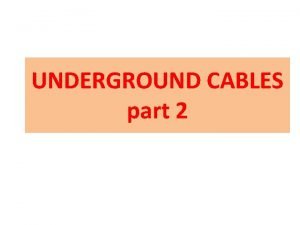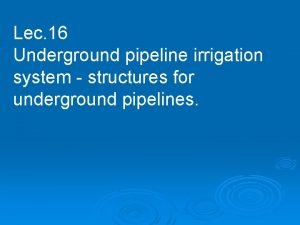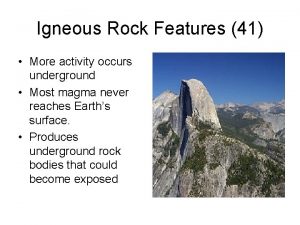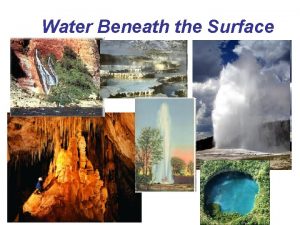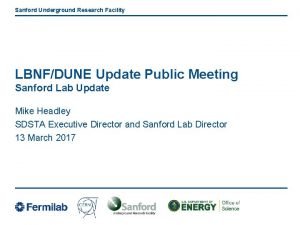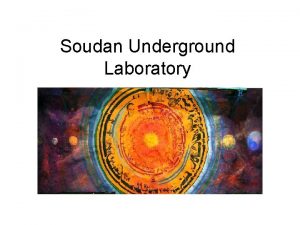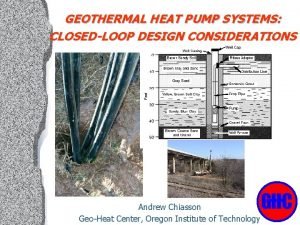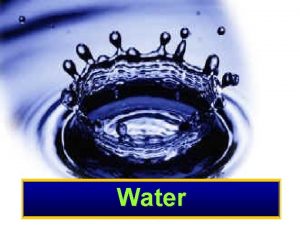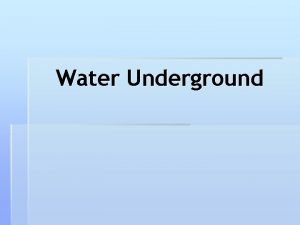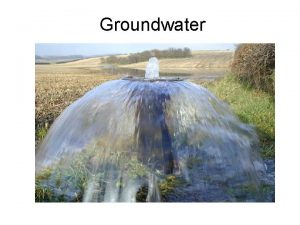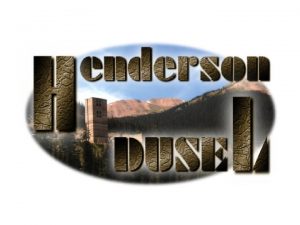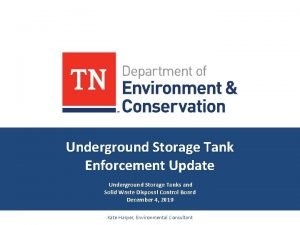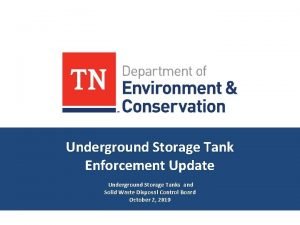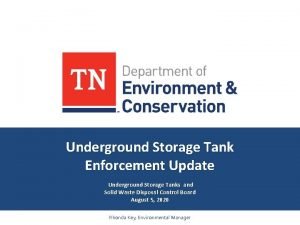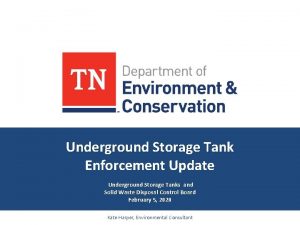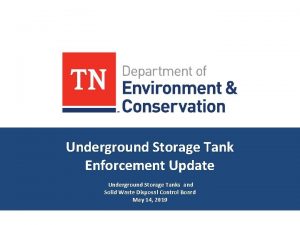Chapter 6 Water Underground The Worlds Water Approx

























































- Slides: 57

Chapter 6 Water Underground

The World’s Water • Approx. 97% of the Earth’s water is salt water. • Approx. 3% is fresh water. – Of this 3%, most of it is frozen in the ice caps and in glaciers. – This leaves only about ½% (0. 5%) of all Earth’s water as usable fresh water. • Most of this usable fresh water is found underground. • All of the Earth’s water is part of the hydrosphere

Water Cycle • Movement of water from one part of the hydrosphere to another is called the water cycle • The energy to start the water cycle comes from the sun (causes evaporation to begin). • Water enters the air as vapor from evaporation (directly from liquid water), transpiration (water vapor given off by plants) and respiration (water vapor given off by animals). • The vapor cools and condenses into clouds, precipitation occurs, and the water flows back into the ground or runs off over the ground into other bodies of water. • This is a continuous cycle.

The Complete Hydrologic Cycle


Our Hydrologic Cycle

Groundwater: Characteristics and Ways we measure and describe how water is transmitted through and held in the ground

How much water can the sediments in the ground hold? • The percentage of pore space in the sediment is called POROSITY • The amount of water that the ground can hold depends on the amount of open space (pore space) between the sediment particles.

The Porosity of the soil depends upon 3 things:

The porosity of the soil depends on: #1) Particle shape- Rounded fragments – Rounded particles do not fit together well, so they will have more space between them. – Angular particles have flat sides that fit together (like a puzzle), and therefore will have less space between them. Which one has higher porosity? Rounded or Angular? Angular Fragments

The porosity of the soil depends on: #2) Sorting • Well-sorted particles (all the same size), don’t fill all the tiny spaces well and have the greatest pore space. • Unsorted particles have small particles which fill in the pore spaces between large particles, decreasing the amount of open space. Well-sorted particles have a greater / lower porosity than unsorted particles


The porosity of the soil depends on: #3) Packing or arrangement • Tightly-packed particles are compressed together densely. The amount of space between the particles is reduced, therefore decreasing the pore space. • Loosely-packed particles are not compressed together. The amount of air space between the particles is higher, therefore increasing the pore space.

******VIF****** Particle size does not affect the porosity!!! Large particles have large spaces between them, but few of them. Small particles have small spaces between them, but many of them. The porosities will be equal!! 9 spaces x 2. 0 cm 3 = 18 cm 3 30 spaces x 0. 6 cm 3 = 18 cm 3

Porosity Percentage Example Before: Beakers filled with 1000 ml of sand (left) and 500 ml of water (right). The water is poured into the sand. After: Sand-filled beaker now contains an additional 350 ml of water. The water filled the original pore spaces that had air in them. The water level in the second beaker had declined from 500 ml to 150 ml. The difference is in the sand-filled beaker. The 350 ml of water filled the pore spaces between sand grains. Therefore, 350 ml of the original 1000 ml sand volume was made up of air-filled pore spaces (porosity = (350 1000) x 100 = 35%).

Permeability Def. - the ability of a liquid to pass through a material’s pore spaces

• Usually, permeability will increase as the size of the particles increases. • The larger the particles, the larger the pore spaces. • Liquids (water) move easier through larger openings. – (water moves easier through a fire hose than through a garden hose)

gravel sand clay

Impermeability • If a liquid cannot pass through a material, then it is considered to be impermeable. • If a material is porous but the pores are not connected, then the material will be impermeable.

• When water infiltrates (soaks) into soil, it gets pulled through the pores by gravity. • The water continues to flow downward until it reaches an impermeable layer. • The water then begins to fill in the pore spaces above the impermeable layer – like filling an ice-filled glass with soda – the soda runs through the gaps in the ice, hits the bottom of the glass and then begins to fill the space in the glass between the ice cubes.


Retention Def. – The amount of water that sticks to the particles and is retained in sediments after the majority of the water flows through.

From what you’ve learned so far this year in our WED unit, what do you think is the biggest factor that affects the retention of water? Hint: Water has adhesive and cohesive properties!!! Based on this and your knowledge of sediments, form a hypothesis… Which soil will retain the most water? Sand, Silt, Clay or Loam (a mixture of the 3)



Capillarity Def. – water’s adhesive ability allows it to “stick” to surfaces and rise above the average surface level of the water

The smaller the space, the better water is able to adhere to and climb up the surfaces. The adhesive force better overcomes the force of gravity pulling the water down This means that capillarity or capillary action is best between SMALL particles or in small cracks in rocks.

– Water has the property of cohesion – the molecules stick to each other very well – Water also has the property of adhesion – the water molecules stick to other surfaces very well.

This helps to explain “surface tension”. This is how so many drops of water will stick to a penny, how we can make a paper clip “float” on water, and how water striders stride! Not all substances that are cohesive are also adhesive. Mercury is VERY cohesive, but NOT adhesive!

• The layer of soil where all of the pore spaces are filled is called the zone of saturation. • The top of this layer is called the water table – it divides the zones of saturation and aeration. • The layer of soil above the water table is called the zone of aeration (air fills the pore spaces). • There is a part of the zone of aeration that is just above the water table called the capillary fringe. – This is where tiny droplets of water move upward by attaching to small particles of soil.


Infiltration Def. – The process by which water that is on the ground’s surface (usually due to precipitation) enters the soil. If the surface water does not infiltrate, it becomes runoff. So, the amounts of infiltration and runoff are inversely (indirectly) related!

The factors that affect the rate of infiltration are: • Particle size • Packing of the particles • Saturation level of the pore spaces • Slope of the ground surface • Vegetation in the area • Ground is thawed or frozen • Amount of asphalt/concrete Let’s examine how each factor affects the rate of infiltration


The Water Table

• The depth of the water table varies, depending upon the amount of rainfall, seasons, climate, soil thickness, etc. • Where the water table does not reach the surface, a pipe may be drilled into the ground down to the water table. • Water may then be pumped out (similar to using a straw to drink with) through the pipe. – This is called an ordinary well. – If the water flows out of the pipe without being pumped, because of the pressure in the ground, it is called an artesian well.


Groundwater below a layer of solid rock or clay is in a confined aquifer. The rock or clay is called a confining layer. A well that goes through a confining layer is known as an artesian well.



• Groundwater usually remains cool all year. Because of its depth, groundwater is not affected by the weather changes at the surface • Below 20 meters deep, water may become heated by the Earth’s interior. If it becomes heated to boiling, hot springs may rise to the surface. They may also erupt as gushing springs of boiling water and steam called geysers – (Yellowstone National Park in Wyoming is famous for its hot springs and geysers)

Groundwater Contamination Groundwater may become polluted by many different means




And the question on everyone’s mind…what does all this have to do with WED? Groundwater causes weathering and erosion by the following means….

• Groundwater can dissolve limestone underground. • Carbonic acid naturally found in groundwater dissolves the calcite in limestone – this is chemical weathering! • Eventually, large portions of the limestone are dissolved and a cavern (cave) may form. – Howe Caverns in upstate New York is an example of a limestone cavern.

Sinkholes





The “Great Blue Hole” Belize. It formed during the last glaciation period when sea levels were much lower.

Guatamala City Sinkhole 2017



Devil’s Sinkhole, Rocksprings, Texas (we HAVE to keep the tradition going!)
 Where is the carrying capacity on a graph
Where is the carrying capacity on a graph Approx mining
Approx mining Worlds together worlds apart 4th edition
Worlds together worlds apart 4th edition Where does underground water come from
Where does underground water come from Zone of aeration and zone of saturation
Zone of aeration and zone of saturation Explain how water erosion by groundwater can form a cave.
Explain how water erosion by groundwater can form a cave. The term geologists use for underground water is
The term geologists use for underground water is Zone of areation
Zone of areation Ten uses of water
Ten uses of water Underground water
Underground water How to find water underground
How to find water underground What's an aquifer
What's an aquifer Water and water and water water
Water and water and water water Tci chapter 19 the worlds of north and south
Tci chapter 19 the worlds of north and south Chapter 24 new worlds the americas and oceania
Chapter 24 new worlds the americas and oceania Chapter 24 new worlds the americas and oceania
Chapter 24 new worlds the americas and oceania Ap world history chapter 20 the americas and oceania
Ap world history chapter 20 the americas and oceania Chapter 12 worlds of the 15th century
Chapter 12 worlds of the 15th century Chapter 12 the worlds of the fifteenth century
Chapter 12 the worlds of the fifteenth century Chapter 10 the worlds of christendom notes
Chapter 10 the worlds of christendom notes Western christendom ap world history
Western christendom ap world history Chapter 24 the americas and oceania
Chapter 24 the americas and oceania The worlds of christendom
The worlds of christendom Chapter 1 three worlds meet
Chapter 1 three worlds meet Secure underground storage
Secure underground storage Properties of underground cables
Properties of underground cables Underground nn
Underground nn Travelcard for london underground
Travelcard for london underground Bow tie quilt pattern meaning
Bow tie quilt pattern meaning Existentialism in notes from underground
Existentialism in notes from underground London underground abstraction
London underground abstraction Underground pipeline for irrigation
Underground pipeline for irrigation Over head service
Over head service Difference between crater and caldera
Difference between crater and caldera Huck finn timeline
Huck finn timeline Underground hyphae
Underground hyphae Underground cap lamp
Underground cap lamp Pictures of the underground railroad
Pictures of the underground railroad Caversham tunnel
Caversham tunnel What is the zone of saturation
What is the zone of saturation Yeoman apush
Yeoman apush Underground dome
Underground dome Xynthia
Xynthia Underground railroad
Underground railroad Sanford underground research facility
Sanford underground research facility How is sassafras's trees roots correctly written
How is sassafras's trees roots correctly written Minecraft underground train station
Minecraft underground train station Slave haven underground railroad museum cost
Slave haven underground railroad museum cost Sandvik
Sandvik Cool underground houses
Cool underground houses What is ariddle
What is ariddle Thick underground stem that lies horizontally
Thick underground stem that lies horizontally Soudan underground laboratory
Soudan underground laboratory The underground seamus heaney notes
The underground seamus heaney notes Why do ants live underground
Why do ants live underground I am round i am brown i grow underground
I am round i am brown i grow underground Geothermal horizontal loop design
Geothermal horizontal loop design Boulby underground laboratory
Boulby underground laboratory
